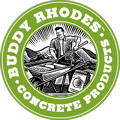Buddy Rhodes Concrete Sealers: Quick Reference and Selection Guide
The charts below may help you decide which sealer best fits your needs. Please review the detailed application instructions for each sealer prior to use. Perform test applications first to determine suitability.
Buddy Rhodes Sealer Options - General Properties Overview
The Buddy Rhodes Sealing System (Penetrating + Satin)
- Easy to use and apply
- Acids may stain
- May scratch
- Satin sheen
- Can perform spot repair
- May be used outdoors if it is protected
ICT Sealer Systems (Includes PS1 & PS1-LS)
- Application technique requires practice, but overall easy to apply
- Needs time to develop stain resistance (wipe all spills immediately for 1 month)
- Works best with Buddy Rhodes high performance concrete mixes (ECC)
- Satin sheen only - no matte option
- Can perform spot repair
- May be used outdoors
Buddy Rhodes Reactive Polyurethane Sealer
- Multiple components to measure
- Application method may require some practice
- Good stain protection
- May scratch
- Gloss to matte finishes possible
- Spot repair difficult - may require more complete reseal
- May be used outdoors if it is protected
Buddy Rhodes Sealer - Quick Selection Guide
KEY: * = Minimal Performance; ***** = Optimal Performance
The Buddy Rhodes Sealing System
Original ICT System (CH Prep + FS Seals)
ICT PS1
ICT PS1-LS
Buddy Rhodes Reactive Polyurethane Sealer SATIN
Buddy Rhodes Reactive Polyurethane Sealer MATTE
What should I seal my concrete with?
This is one of the most common questions we hear. The fact is that there is no single sealer that works for all circumstances and all users. Every sealer has pros and cons that must be considered for a given project. It is important to understand your project and know what is required of the sealer. Select the sealer that best matches the highest number of project requirements. Make a sample project and test the sealer to determine suitability.
Here are some of the factors to consider:
- Final Appearance – Should the sealer have a satin or matte finish? High build, plastic look or natural appearance?
- Ease of Use – Is a sealer a single component wipe on material that virtually anyone can apply with little experience? Or is it multiple components where measuring and mixing are required, followed by multiple applications? Does the person applying the sealer have the experience to achieve a uniform finish without application marks?
- Scratch Resistance – All sealers will scratch given a particular circumstance, but which ones will scratch the least? The actual surface profile of the concrete can help. Imperfections on a glossy surface will catch the light and stand out. That is why matte finishes are favorable for many surfaces, because fine scratches are less visible. Microscopic surface texture from acid etching will also help reduce visible scratching on certain topical sealers.
- Stain Resistance – Does it allow for a spill to be left to dry without fear of a permanent stain or do certain spills need to be wiped up as they happen to protect from harm?
- Repairability – When a blemish occurs, can a localized area be repaired and resealed, or does the entire surface need to be resealed?
- Project Type - Is it a kitchen countertop or piece of sculpture? The sealer for each may require specific properties or method of application.
- Interior vs. Exterior - Interior surfaces are protected from the elements, take less abuse and therefore most sealers are suitable. If the project is going outdoors, topical sealers are less desirable, especially if exposed to freeze-thaw conditions.
- Suitability for a Specific Use – Does it need to hold up to the abuse of a commercial bar, or is the project intended for limited residential use?



